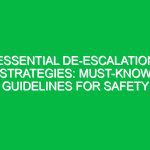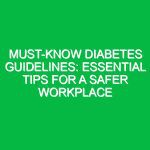“`html
Essential Defensive Driving Guidelines: Avoid Common Risks Today!
Introduction
Good morning team! Today, we’re diving into a crucial topic that affects not only our Safety on the road but also our overall workplace wellbeing—defensive driving. Understanding and implementing defensive driving guidelines is essential for avoiding common risks that can lead to accidents and injuries. It’s not just about getting from point A to point B; it’s about ensuring that everyone gets home safely at the end of the day.
This Toolbox Talk aims to equip you with practical strategies and insights into defensive driving, helping us all to be more aware drivers. Remember, safety doesn’t happen by accident!
Understanding Defensive Driving
Defensive driving is a set of driving skills and techniques that help drivers anticipate potential Hazards and react appropriately. It’s about being proactive rather than reactive. The importance of defensive driving in Workplace Safety cannot be overstated; it directly impacts our daily operations, especially for those of us who drive as part of our job.
Many people mistakenly believe that defensive driving is only for new drivers or those who have recently been in an accident. However, it is a continuous practice that Benefits all drivers, regardless of experience. By adopting defensive driving techniques, we can minimize risks and enhance safety for ourselves and others on the road.
Key Hazards, Risks, and Safety Considerations
Every time we get behind the wheel, we face a variety of hazards and risks. Here are some specific challenges associated with driving that we must be aware of:
- Distracted Driving: Engaging with mobile devices, adjusting radio settings, or talking to passengers can take your focus away from the road.
- Weather Conditions: Rain, snow, fog, and ice can significantly alter driving conditions, making it crucial to adjust our driving accordingly.
- Speeding: Driving over the speed limit increases the likelihood of accidents, especially in congested areas.
- Fatigue: Tired drivers are less alert and may not react quickly to sudden changes on the road.
- Impaired Driving: Driving under the influence of alcohol or drugs poses a severe risk to all road users.
Ignoring these risks can lead to real-world consequences, including accidents that can cause injuries or fatalities. It’s critical that we take these warnings seriously to protect ourselves and our colleagues.
Best Practices, Procedures, & Actionable Advice
To minimize risks and ensure safety on the road, here are some Best Practices you should follow:
- Stay Focused: Keep your eyes on the road and avoid distractions. If you need to make a call or send a message, pull over safely first.
- Adjust Your Speed: Always adhere to speed limits and adjust your speed based on road conditions, such as heavy rain or fog.
- Maintain Distance: Keep a safe following distance from the vehicle in front of you. A good rule of thumb is the three-second rule—maintain at least three seconds of distance to react if necessary.
- Use Turn Signals: Always signal your intentions to other drivers to avoid confusion and potential accidents.
- Perform Regular Vehicle Maintenance: Ensure your vehicle is in good working condition. Regular checks on brakes, tires, and lights can prevent many accidents.
For example, consider a recent incident where a driver was distracted by their phone and did not notice the traffic slowing ahead. This resulted in a rear-end collision, causing injuries to both parties involved. By following defensive driving guidelines, such incidents can be avoided.
Regulations, Standards, and Compliance
It’s essential to be aware of relevant Regulations that govern Safe Driving Practices. The Occupational Safety and Health Administration (OSHA) provides guidelines that emphasize the importance of safety in the workplace, including when driving. Adhering to these regulations not only protects you but also reduces the liability for our company.
Compliance with safety Standards is critical. Failing to follow these regulations can lead to severe consequences, including fines, accidents, and injuries. Always stay informed about the safety policies relevant to your driving duties.
Employee Engagement & Discussion
Let’s take a moment to discuss this further. What safety challenges have you encountered related to driving? Are there any situations you find particularly difficult to navigate? Sharing your experiences can help us all learn and improve our defensive driving skills.
Feel free to speak up during our discussion, as your insights are invaluable in creating a safer working Environment.
Conclusion & Key Takeaways
To wrap up, let’s remember the essential defensive driving guidelines we’ve discussed today. By staying focused, adjusting our speed, maintaining a safe distance, using turn signals, and ensuring our vehicles are well-maintained, we can significantly reduce the risks associated with driving.
Prioritizing safety is a collective responsibility, and by applying these practices, we enhance not only our safety but also the safety of our colleagues and the public. Thank you for your attention and commitment to making our workplace safer. Let’s put these defensive driving guidelines into practice today!
“`


